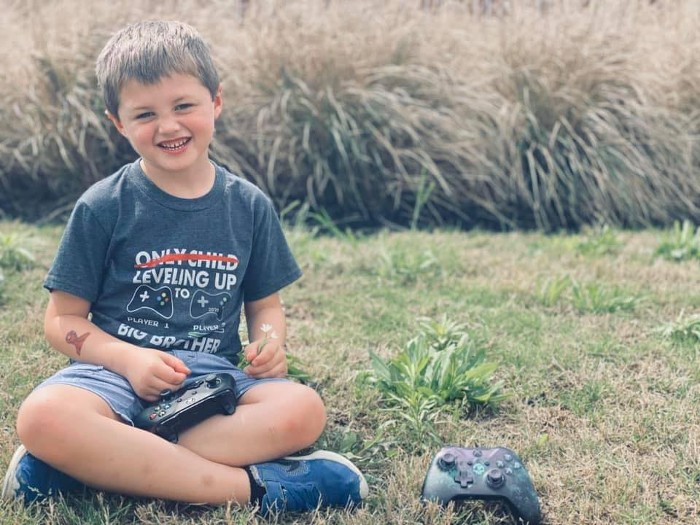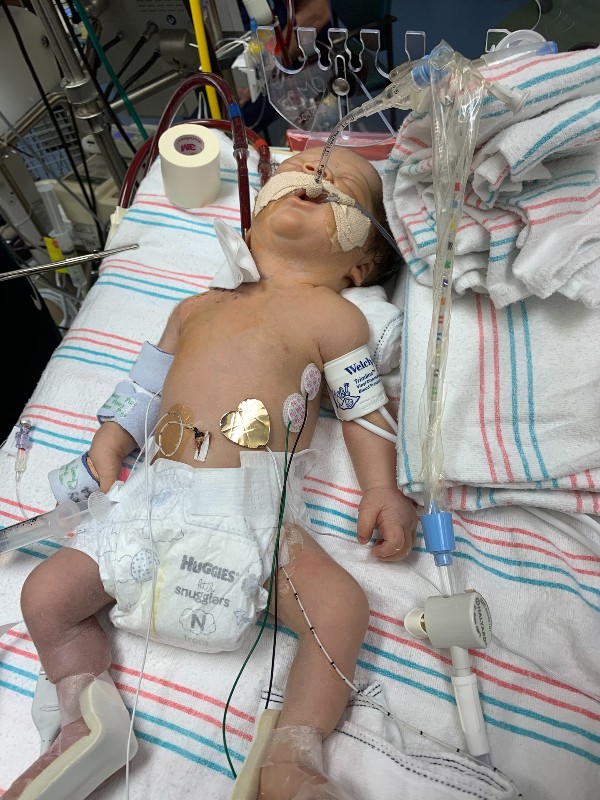
“One night, we found ourselves discussing Liam’s upcoming full-time schooling and my potential return to part-time work,” Elizabeth recalled. “I mentioned my plans, and then Micah surprised me, asking, ‘What if I wanted one more?” That’s when we agreed to try for another child.”
In the spring of 2020, Elizabeth received the news she had hoped for – two positive lines on the pregnancy test. “We were ecstatic,” she exclaimed. “We shared the news with Liam, preparing him for the role of big brother, and we spread the joyous announcement to everyone we knew.”
Elizabeth’s pregnancy
Elizabeth visited her OBGYN regularly in San Antonio. Throughout her pregnancy, she endured severe and constant morning sickness. The relentless nausea made each day a struggle, compounded by the stringent COVID-19 regulations of 2020 which left her attending appointments alone.
When the 20-week anatomy scan came around, the ultrasound technician couldn't get a clear view of the baby’s heart, a boy they planned to name Landon. The technician asked Elizabeth to schedule another visit. At first, Elizabeth and Micah didn’t think much of it.
When Elizabeth came in for a second scan a week later, things felt off. The ultrasound technician kept going back to the same spot, muttering about the baby's diaphragm. Finally, she broke the silence with, "I can't see his diaphragm. It's there... and then it stops. I need to contact your OBGYN. I'll be back."
“I was shocked,” said Elizabeth.
When Elizabeth’s OBGYN reviewed the ultrasound, she suspected Landon had congenital pulmonary airway malformation (CPAM), a rare lung disease where abnormal tissue growth can lead to cysts or abnormal airways, but told her not to worry about it.
But Elizabeth couldn't shake the feeling that something wasn't right. She was referred to a maternal fetal medicine (MFM) doctor for further evaluations.
“I knew I needed to advocate for our baby and do everything I could to make sure we figured out what was really going on with Landon," said Elizabeth.
Elizabeth actually consulted with several MFMS and one in particular had a different suspicion —he thought Landon might have congenital diaphragmatic hernia (CDH). He ordered an MRI to confirm.
On August 24, 2020, Elizabeth, now 27 weeks pregnant, was anxiously awaiting the results of the MRI which she thought would confirm CPAM. “When I went in for the results, I was completely blindsided.”
Anticipating a discussion about CPAM, Elizabeth and her husband, who joined the appointment via phone, were stunned when the MFM specialist revealed a congenital diaphragmatic hernia (CDH). The doctor’s words painted a bleak picture: their son’s chances of survival seemed slim, with even the possibility of only a few minutes of life after birth appearing uncertain.
"While showing us the scan, the doctor explained that my son’s intestines had merged into his chest cavity along with his liver,” said Elizabeth. “He mentioned that typically, this condition would be found on the left side, but our son's case was on the right. He expressed grimly that our son probably wouldn't survive birth, and if he did, we'd likely have only a few moments with him. The doctor told us they were sending our MRI scan to a specialist in Houston for review. He concluded with an apology, stating, 'I am sorry. There is nothing we can do for you,' and passed me a tissue before leaving.'"
Elizabeth and Micah grappled with the doctor’s prognosis, feeling like he had sealed their son’s fate.
A glimmer of hope
The Cummins however did follow up on the referral to The Fetal Center at Children’s Memorial Hermann Hospital where they met with Matthew Harting, MD, a pediatric surgeon, and Anthony Johnson, MD, a maternal-fetal-medicine specialist, both affiliated with Children’s Memorial Hermann Hospital. Through their explanations and plans, a glimmer of optimism emerged.
Despite initial thoughts, it appeared their son might not need fetal endoscopic tracheal occlusion (FETO) and could have a fighting chance at life – one of the options for treating CDH before a baby is born. FETO involves inserting a balloon into the baby’s trachea (windpipe) while still in utero to block the flow of amniotic fluid into the lungs. This procedure can enhance lung growth in babies with CDH and increase their chances of survival after birth.
“Within a few hours of discussing and them explaining the plan, we found hope,” Elizabeth recalled. “He did not need FETO. He was right-sided, but that didn’t mean they couldn’t help him.”
After the CDH diagnosis, Elizabeth returned to her OB-GYN and MFM physicians in San Antonio for biweekly ultrasounds and stress tests that would be sent to Children’ Memorial Hermann Hospital.
The Cummins made monthly trips to Memorial Hermann, increasing to twice a month as Elizabeth's delivery date approached. The family moved to Houston just a few weeks before Landon's delivery.
Landon’s birth

“Landon had a severe right-sided (less common side) CDH,” explained Dr. Harting. “He was missing about 75 percent of his diaphragm. We repaired his CDH while he was on heart-lung support from ECMO, returning the abdominal organs (liver, intestines) to the abdomen and building a new diaphragm for him using a special patch.”
“Landon surprised everyone by recovering with such speed,” said Elizabeth. “Nothing slowed him down. He was off ECMO in seven days. A week later, he was on CPAP, a less invasive method of respiratory support, allowing him to breathe more independently while still receiving assistance as needed. He continued to recover quickly. On December 5, 2020, we were finally able to take Landon home after spending 31 days in the NICU.”
Landon's transition from ECMO to Continuous Positive Airway Pressure (CPAP) marked a significant milestone in his recovery, signaling improved respiratory function and the ability to manage without the intensive support of ECMO.
Landon today
Today, 3-year-old Landon is a bundle of energy! He's daring, confident, and so loving. His big brother Liam is his best friend. Since his autism diagnosis in April 2023, Landon faces communication challenges and often struggles to express himself. When kids ask why Landon doesn’t “talk right” or why he doesn’t answer questions, Liam always explains that his brother was born with CDH and has autism, but he loves to play just like anyone else but in his own way. The Cummins say Landon is an inspirational to them all.
“We are immensely grateful to all of the doctors and nurses who took care of Landon, and gave our little guy hope,” said Elizabeth. “Their dedication was truly remarkable. Every nurse, doctor, surgeon, and every specialist involved in Landon’s care made us feel welcome, heard and valued. They were all wonderful. We cherish Landon dearly and are overjoyed to have him with us today as part of our family.”
As part of his follow-up care, Landon is a patient at the Multidisciplinary Clinic for Congenital Diaphragmatic Hernia for regular check-ups to monitor his growth and development, and address any potential late-onset complications or issues related to CDH.
“The Cummins family is truly amazing,” said Harting. “Mrs. Cummins is a remarkable advocate for families in the CDH community. She generously shares her time and wisdom to help others. We’re also incredibly grateful for her husband’s service and sacrifice in the military. Landon’s future looks bright, and we’re honored that the Cummins family trusted our teams to play a part in giving Landon a new chance at life.”